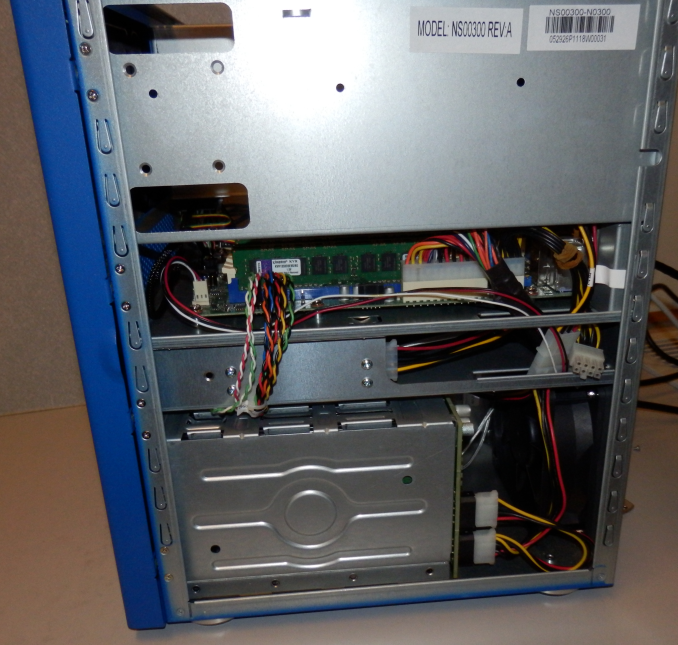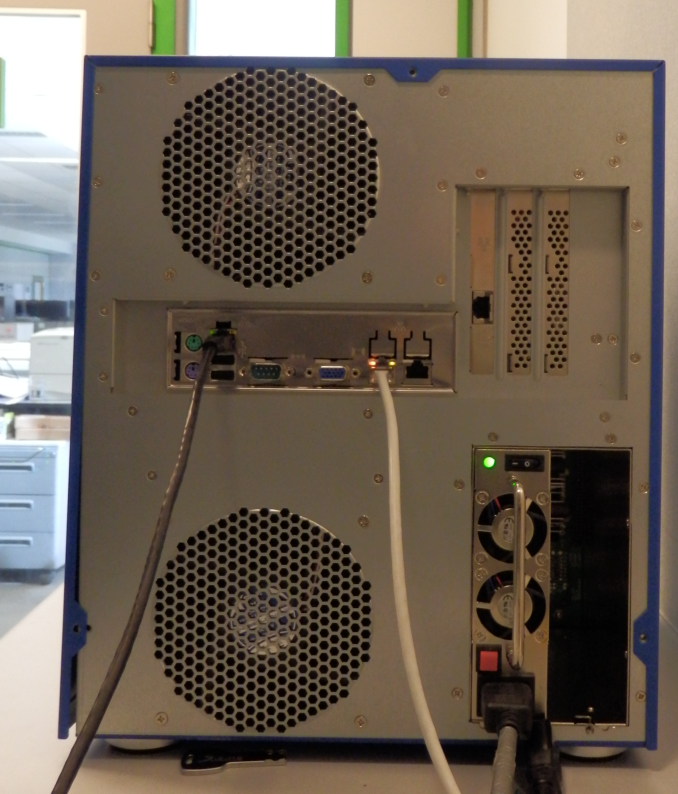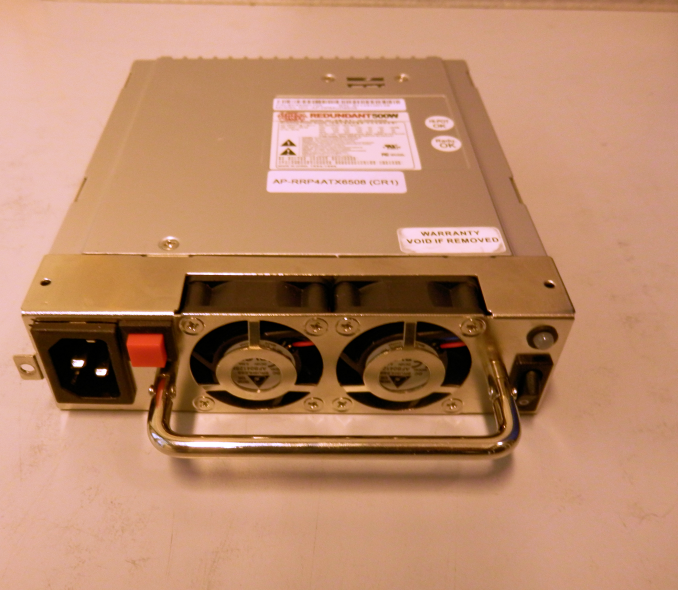Advatronix Cirrus 1200: a Storage Server Under Your Desk
by Johan De Gelas on June 6, 2014 5:00 AM ESTMore Internals
When you look at the interior from the right side, you'll notice a large fan sucking air over one of the disk modules.
The focus on keeping the drive bays cool gets even more obvious when we take a look at the rear of the Advatronix Cirrus 1200. There are two large, robust 120mm fans that suck the hot air out of the drive bays.
The redundant PSUs are very easy to replace and hot-pluggable.
We tested the redundant PSUs to verify a single PSU can handle the entire load and experienced no problems. At least in the area of PSU redundancy, then, the Cirrus 1200 is server grade.
To sum things up, the Cirrus 1200 has several server grade features such redundant PSUs and hot-pluggable, easy to access drive bays, and it's not too difficult to service. However, it is also a lot like a desktop, as the CPU needs a fan that is hard to reach, and you need to use a screwdriver quite a bit to replace the fans. Also, the cabling inside must be treated with care, as it is easy to damage or pull out cables by accident. Advatronix still has some work to do before they truly can call the Cirrus "a data center in a box".













39 Comments
View All Comments
thomas-hrb - Friday, June 6, 2014 - link
If you looking at storage servers under the desk why not consider something like the DELL VRTX. that at least have a significant advantage in the scalability department. You can start small and re-dimension to many different use cases as you growJohanAnandtech - Friday, June 6, 2014 - link
Good suggestion, although the DELL VRTX is a bit higher in the (pricing) food chain than the servers I described in this article.DanNeely - Friday, June 6, 2014 - link
With room for 4 blades in the enclosure the VRTX is also significantly higher in terms of overall capability. Were you unable to find a server from someone else that was a close match in specifications to the Cirrus 1200? Even if it cost significantly more, I think at least one of comparison systems should've been picked for equivalent capability instead of equivalent pricing.jjeff1 - Friday, June 6, 2014 - link
I'm not sure who would want this server. If you have a large SQL database, you definitly need more memory and better reliability. Same thing if you have a large amount of business data.Dell, HP or IBM could all provide a better box with much better support options. This HP server supports 18 disk slots, 2 12 core CPUs, and 768GB memory.
http://www8.hp.com/us/en/products/proliant-servers...
It'll cost more, no doubt. But if you have a business that's generating TBs of data, you can afford it.
Jeff7181 - Sunday, June 8, 2014 - link
If you have a large SQL database, or any SQL database, you wouldn't run it on this box. This is a storage server, not a compute server.Gonemad - Friday, June 6, 2014 - link
I've seen U server racks on wheels, with a dark glass and keys locking it, but that was just an empty "wardrobe" where you would put your servers. It was small enough to be pushed around, but with enough real estate to hide a keyboard and monitor in there, like a hypervisor KVM solution. On the plus side, if you ever decided to upgrade, just plop your gear on a real rack unit. It felt less cumbersome than that huge metal box you showed there.Then again, a server that conforms to a rack shape is needed.
Kevin G - Friday, June 6, 2014 - link
Actually I have such a Gator case. It is sold as a portable case for AV hardware but conforms to standard 19" rack mount widths and hole mounts. There is one main gotcha with my unit: it does't provide as much depth as a full rack. I have to use shorter server cases and they tend to be a bit taller. It works out as the cooling systems of taller rack cases tend to be quieter and an advantage when bring them to other locations An more of a personal preference thing but I don't use sliding rails in a portable case as I don't see that as wise for a unit that's going to be frequently moved around and traveling.martixy - Friday, June 6, 2014 - link
Someone explain something to me please.So this is specifically low-power - 500W on spec. Let's say then that it's a non-low-power(e.g. twice - 1kW). I'm gonna assume we're threading on CRAC territory at that point. So why exactly? Why would a high powered gaming rig be able to easily handle that load, even under air cooling, but a server with the same power factor require special cooling equipment with fancy acronyms like CRAC?
alaricljs - Friday, June 6, 2014 - link
A gaming rig isn't going to be pushing that much wattage 24x7. A server is considered a constant load and proper AC calculations even go so far as to consider # of people expected in a room consistently, so a high wattage computer is definitely part of the equation.DanNeely - Friday, June 6, 2014 - link
I suspect it's mostly marketing BS. One box even a high power one that's at a constant 100% load doesn't need special cooling. A CRAC is needed when you've got a data center packed full of servers because they collectively put out enough heat to overwhelm general purpose AC units. (With the rise of virtualization many older data centers capacity has become a thermal limit instead of being limited by the number of racks there's room for.)At the margin they may be saying it was designed with enough cooling to keep temps reasonable in air on the warm side of room temperature instead of only when it's being blasted with chilled air. OTOH a number of companies that have experimented with running their data centers 10 or 20F hotter than traditional have found the cost savings from cooling didn't have any major impact on longevity so...